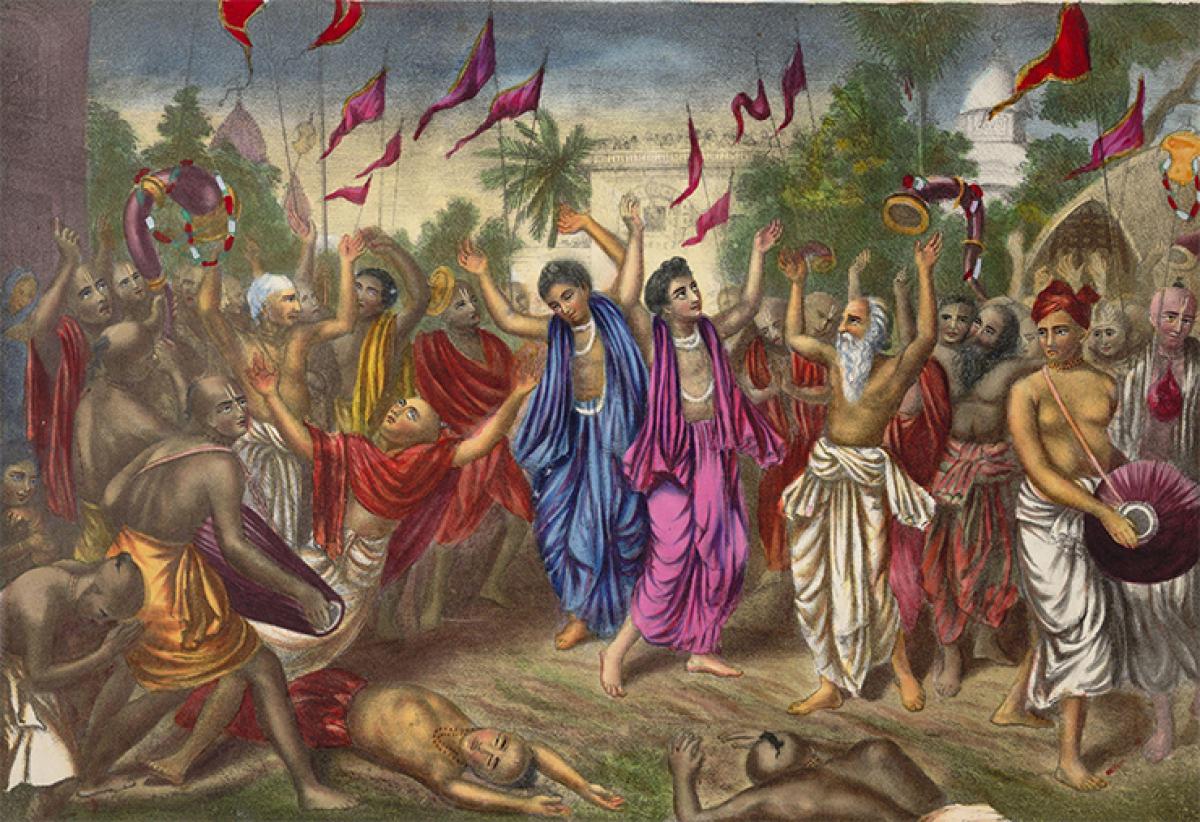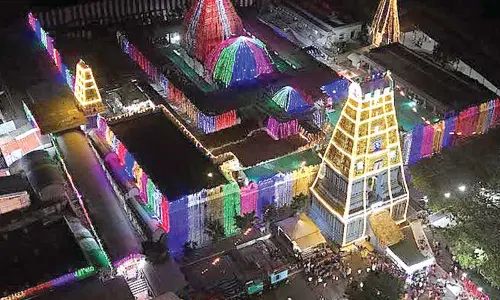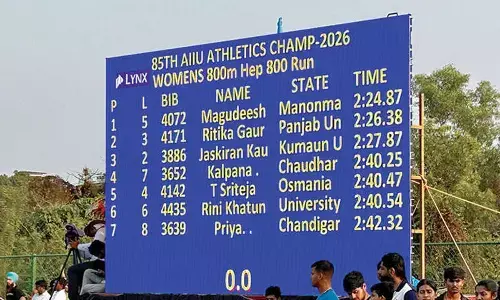The Bhakti Movement

The Sufis were not the only popular religious teacher of the time. There were also the Bhakti saints. Their teachings were similar to those of the Sufis but they had been teaching for a longer time. They were popular among the artisans, craftsmen and traders in the towns. The people in the villages also flocked to listen to them.
The Sufis were not the only popular religious teacher of the time. There were also the Bhakti saints. Their teachings were similar to those of the Sufis but they had been teaching for a longer time. They were popular among the artisans, craftsmen and traders in the towns. The people in the villages also flocked to listen to them.
The Sufi and Bhakti saints had many thoughts and practices in common. Their essential belief was in the time of need to unite with god. They laid stress on love or devotion as the basis of the relationship with God. To achieve all this a Guru or a Pir was needed.
The Bhakti saints attacked the rigidity in religion and the objects of worship. They disregarded caste and encouraged women to join in their religious gatherings. The Bhakti saints did their entire teaching in the local vernacular language to make it comprehensible even to simple minds.
The Bhakti saints belonged to various backgrounds but mainly from the lower castes Many were artisans by origin or belonged to the less prosperous class of cultivators. They stressed the need for tolerance among humans and religions. The Bhakti movement was long known in the South. The idea of preaching Bhakti through hymns and stories was traditionally done by the Alvars and the Nayannars of the Tamil devotional cult.
Guru Nanak
Guru Nanak was born of a Khatri family in the village of Talwandi which is now called Nankana. Though Guru Nanak was trained in accountancy, he preferred the company of saints and sufis. Some time later, he had a mystic vision. He left home for the company of saints and pirs.
He composed hymns and sang them to the accompaniment of the ‘rabab’, which is a musical instrument. His hymns are popular even today. He emphasised love and devotion for the one and only God. He strongly denounsed idol worship, pilgrimages, sacrifices and rituals as a way to achieving God.
He demanded purity of character and conduct as the first condition of approaching God. He believed that anyone could achieve a spiritual life while doing his duties as a householder.
How did the Bhakti movement became so popular with the people?
An important reason was that they challenged the caste system and the superiority of the Brahmanas. They welcomed the ideas of equality and brotherhood which the Sufi saints also preached. People were no longer satisfied with the old religion. They wanted a religion which could satisfy both their rationality as well as emotions.
All the Bhakti saints emphasised oneness of God. They said that the path to God lay in devotion and Bhakti to Him and not in any rituals. They condemned rituals and sacrifies. In northern India, it developed into two streams, nirguna bhakti and saguna bhakti. The nirguna bhaktas were devotees of a formless God even while calling him variously as Rama, Govinda, Hari or Raghunatha. The most conspicuous among them were Kabir and Nanak.
The saguna bhaktas were devotees of Rama, the son of Dasharatha, or Krishna, the son of Devaki and Vasudeva. Some of the best examples of Saguna bhaktas were Tulsidas, who idolised Rama in his famous Ramcharita Manas, and Surdas, who sang praises of Krishna in his famous Sursagar. Raskhan, a Muslim poet, who was a devotee of Lord Krishna, also belonged to this tradition.
The first important feature of bhakti movement was the concept of oneness of God and brotherhood of all human beings. It did not discriminate against anyone on the basis of caste or gender. Its second important feature was surrender into God, who is all pervasive and capable of solving the problems of the devotees.
The third important feature of bhakti was an intense personal devotion to God with an emphasis on a good moral life. It was felt that chanting the name of God constantly purified the soul and prepared one for His grace. A true devotee does not want heaven or moksha.
He only wants to chant the Lord’s name and be born again and again to sing His praise. In addition, came the guru or spiritual teacher, whose function was to provide people with hope, strength and inner courage. He was supposed to be a person who had marched ahead on the path of bhakti and had probably realised God and hence was capable of leading others into Him.
This brought in a system of pahul. Pahul was the sanctified water offered by a master to the pupil or shishya as a token of his being accepted as a trainee on his march to godliness. The Sikhs performed “washing of the swords” ceremony, called khande ka pahul, evolving as the pir-muridi custom (the saint-soldier concept).
Have you been able to notice here some features of the Bhakti tradition, which were similar to the practices and ideas of the Sufis? The spirit of Bhakti pervaded the whole of India and found vivid and beautiful expression in the religious poetry of the medieval saints and mystics, no matter what religious faith they believed in.
Their literary compositions, rendered into geet, qawali, etc united the people, as nothing else could have done. It also stimulated the development of regional languages.
Ramanuja
Ramanuja was from the South and he taught in the language of the common people. His disciple was Ramananda who took his Guru’s message to the northern parts of India.
Ramananda
Ramananda was born at Allahabad and educated at Varanasi. He preached at both these places. He wanted to rid the Hindu religion of its evil customs and practices. He wanted people to know that all men were equal in the eyes of God and there was nobody high born or low born. His followers belonged to diferent walks of like. For example, Kabir was a weaver, Sadhana was a butcher, Ravidasa was a cobbler and Sena was a barber.
Kabir
Kabir was Ramananda’s favourite disciple. Like Nanak, he criticised the existing social order and called for Hindu-Muslim unity. Kabir, the son of a Muslim weaver, strongly denounced idol worship, taking part in formal worship such as Namaz, pilgrimages or bathing in rivers. He wanted to preach a religion which was acceptable to all and that would unite all religions. He emphasised the unity of God. He called Him by several names such as Rama, Gobinda, Hari and Allah. Kabir’s doha’s are famous even now
Chaitanya
Mahaprabhu Chaitanya was a saint from Bengal. He was a devotee of Lord Krishna. Though he was a Brahman he condemned the caste system and emphasised on the equality of all. He wanted the people to know that true worship lay in love and devotion. He used to go into a trance singing devotional songs in praise of Lord Krishna.
Mirabai
Mirabai was another Bhakti Saint who worshipped, composed and sang songs in praise of Lord Krishna. Like Chaitanya, she too would go into a trance in her love for the God.
Namadeva
Namadeva was a tailor. He wrote in Marathi. His poetry spoke of intense love and devotion to God.

















